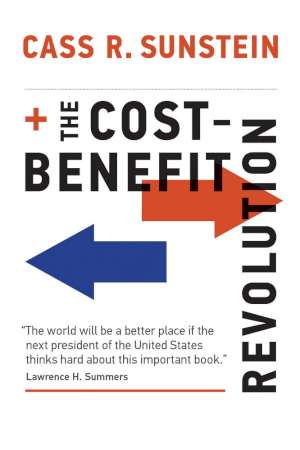25 March 2019
The Cost‑Benefit Revolution
Cass R Sunstein
2018, MIT Press, 288 pages,
ISBN 9780262038140
Reviewer: Jonah P Adaun

Cass.R. Sunstein (a lawyer not economist by background) is a former adviser to Barack Obama as the Administrator of the White House Office of Information and Regulatory Affairs between 2009-2012. He also co-authored Nudge: Improving Decisions about Health, Wealth and Happiness and uses insights from some of his theoretical examples when exploring where cost-benefit-analysis (CBA) – weighing up the bad and good effects of policies, ideally with monetary figures – can be applied.
The book is really about an exploration of the role of CBA in government policy making. With the aim of ensuring decision making is based on facts and evidence as it emerges. This process is designed to remove the passion or values people hold dear on social problems like child obesity, illegal immigration, highway safety, terrorism or climate change. It is written in accessible way so can be digested by non-economists too.
He explores some very interesting areas where CBA could be applied including privacy and national security and, even, free speech. The conclusion here was that there are some things society values even at very high costs: for example, interventions to reduce or eliminate the risks of nuclear power – and, also, interventions to reduce the likelihood of terrorist attacks.
The most compelling ideas that rang home to me as a government economist were his four reforms to help us tackle the knowledge problem which can be summarised as identifying the correct costs and benefits (good and bad things) of a specific policy intervention. These reforms are: 1) notice-and-comment, 2) retrospective analysis of rules, 3) careful experiments and 4) measure and react. These reforms are very simple and yet powerful since they promise evidence-based policy making or at least moving us closer in that direction. In essence these reforms allow regulators to refine their evidence as new information emerges, whether to the contrary or in support of the intervention.
Another compelling idea in the book is the attempt to make social (human) welfare and the maximisation of this rather than the weighed-up costs and benefits as the main justification for any particular intervention where greater benefits give evidence for action over a specified period of time. This seems to take us into the age-old debates of the greatest happiness principle which John S. Mill espoused along with Jeremy Bentham but in a more modern context so long as this does not contradict universally accepted truths like human rights or national security. Sunstein seems to offer some suggestions of how we get there through surveys and willingness to pay to develop this evidence base including the four reforms he mentioned.
One thing this book certainly achieves is that it celebrates the long road CBA has come since the early 1980s, and the support and commitment it has received from successive governments. It has made governments work better especially where the analysis has been done properly and taken into account by the highest-level officials. It has saved lives (and money too). Despite the good things it has spurred (including things made better) and the bad stopped, the revolution is still not here and indeed CBA might be a means to something far more superior in helping us to understand the implications of public sector initiatives.
